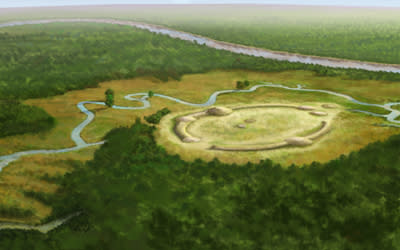This Louisiana archeological site is older than the Egyptian pyramids

LOUISIANA (KLFY) — In Louisiana sits an ancient archeological site, even older than the Egyptian pyramids and Stonehenge.
Ouachita Parish in north Louisiana is home to the oldest earthwork mound complex in North America, constructed approximately 5,400 years ago, known as Watson Brake. This ancient archeological site was built around 1,000 years before the Egyptian pyramids and Stonehenge, and about 1,900 years before the other ancient archeological site in Louisiana, Poverty Point.
This Louisiana facility finds colliding black holes billions of light-years away

Watson Brake went undiscovered until 1981, when after logging had cleared much of the area, Reca Bamburg Jones, a local resident, identified the pattern of eleven mounds connected by ridges. The earthwork makes an oval formation, and is approximately 280 yards across. The site had been privately owned since the 1950’s, with half of it still being owned by several family members of the Gentry family who allow archaeologist to conduct research and excavations. The other half was purchased by The Archaeological Conservancy and later sold to the state for preservation.
Radiocarbon dating suggest that the area was initially occupied around 4,000 BCE during the Middle Archaic period, with construction of the site beginning around 3,500 BCE and continued for approximately 500 years. For context, tin was first discovered around 3,500 BCE, and Sumerians developed cuneiform, the first writing system.
Thanks for signing up!
Watch for us in your inbox.
Subscribe Now
KLFY Daily Digest
Excavations of the site indicate the mounds were enlarged in several stages, leaving sufficient time in between building for trash deposits from residents to accumulate on top of the mounds and ridges. Evidence of trash build up indicates Watson Brake may have been used as a base for mobile hunter-gather groups throughout summer and fall.
Ancient archeological sites like Watson Brake and Poverty Point show that pre-agricultural, pre-ceramic, indigenous cultures in the United States were much more complex than previously thought. The development of these sophisticated monuments has caused scientists to analyze these hunter-gatherer peoples closer and push the boundaries of what they were previously believed to be capable of.
Latest Posts
Vermilion River section to be dredged after city council approval
Colleges begin receiving student FAFSA information after months of delays
Boeing whistleblower who raised production concerns found dead at 62
Messi the dog made it to the Oscars. Here’s how the show pulled off his clapping cameo
For the latest news, weather, sports, and streaming video, head to KLFY.com.

